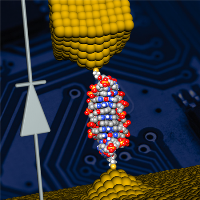The diode is an electronic element that allows current to flow in one direction, but prevents its flow in the other direction. It is a central element in common and prolific electronic devices, such as mobile phones and computers and essentially any electronic appliance.
In a US-Israeli collaborative effort, University of Georgia and BGU researchers were able to create and characterize the world’s smallest diode - one molecule small!

Illustration of the coralyne-intercalated DNA junction used to create a single-molecule diode, which can serve as an active element in future nanoscale circuits.
The success was achieved by Prof. Bingqian Xu of the College of Engineering at the University of Georgia, USA, and Dr. Yoni Dubi from the Department of Chemistry at BGU.
In Prof. Xu’s group, the researchers took a single DNA molecule constructed from 11 base pairs, and connected it to an electronic circuit (only a few nanometers large). When they measured the current through the molecule, the researchers found that the molecule did not show any special behavior. However, when the DNA was intercalated with a molecule named coralyne, the behavior of the circuit changed drastically – now, the current was 15 times larger for negative voltages than for positive voltages, a necessary feature for a diode. The researchers deduced that they had created a diode composed of a single DNA molecule.
To understand the origin of this feature, Dr. Dubi and his student, Mrs. Elinor Zerah-Harush, used the results of the experiment to construct a theoretical model of the DNA molecule inside the electric circuit. The model allowed them to identify the source of the diode-like feature: it originates from the breaking of spatial symmetry inside the DNA molecule after the coralyne is inserted.
The results of this study, which were published online in Nature Chemistry on April 4, 2016, are a milestone in the creation of molecular electronic devices, and shed light on the electronic transport mechanism in DNA. The research demonstrated for the first time that one can make tiny electronic elements from single DNA molecules! This can lead to progress in the design and construction of nano-scale electronic elements (the smallest elements available now are typically 1000 times larger). The two teams are continuing the collaboration, with the common goal of constructing more molecular devices and enhancing the performance of the molecular diode.
